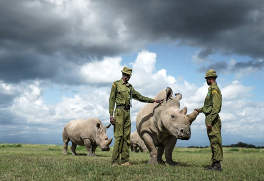Abigail Yarrison ’24, Managing Editor

On March 19, 2018 an irreversible event took place that no one heard about. On a conservation ranch in Kenya, the last male Northern White Rhino, Sudan, died. His caretakers who had been with him through his life on Ol Pejeta laid their hands on his skin for their final goodbyes. When Sudan died, his bones were collected to someday hang in a museum where children could learn, as Sam Anderson, a writer for the New York Times writes, “that one day there had been a thing called a northern white rhino.”
We shouldn’t still be making dinosaurs. How sad is it that our reality is that extinction isn’t a thing of the past, it’s still happening today? Scientist believe that some animals go extinct before they are ever even discovered. According to the IUCN Red List, as of 2020 more than 35,000 species are endangered. Of that number 7,762 species are classified as critically endangered.
The Northern White Rhino belongs to this category. Herds of them used to roam the savannas of East and Central Africa, a sizeable presence shadowed only by the largest land mammals, elephants. And like elephants, their horns were, and are, valued for trophies or powdered and used for medicine. Poachers prowled Africa taking down these beautiful giants left and right. There used to be many more rhinos in the area of Ol Pejeta, a conservation ranch in Kenya, but now all that’s left of them is a rhinoceros graveyard. A memorial to the fallen.

Sudan was lucky enough to die of natural causes. And lucky for us, he was not the last of his kind. He is succeeded by his daughter, Najin, and his granddaughter, Fatu, who are protected day and night by armed guards. Unfortunately, Sudan was the last male so it is now impossible for Najin and Fatu to reproduce. At Ol Pejeta, the caretakers can only wait as a little more greatness disappears from the world.
The situation of the girls is called “functionally extinct.” The Northern White Rhinos, along with the South China Tiger and Christmas Island Shrew, are functionally extinct because of their inability to reproduce, or the existence of individuals only in captivity. But just like Miracle Max informed us in The Princess Bride, “There’s a big difference between mostly dead and all dead. Mostly dead is slightly alive.” There is a tentative recovery plan for the Northern White Rhinos. When Sudan died, the last of his sperm was collected. In August 2019 Najin and Fatu went through a procedure to harvest their eggs. Of the ten extracted, three have grown into embryos, currently frozen until further actions can take place. The next step is to implant the embryo in a female Southern White Rhino to be gestated and birthed.
A century ago, this plan would not be possible because of the vulnerable situation of the Southern White Rhinoceros species. Poaching and another form of endangerment, degradation, devastated their population. Due mostly to human activities, the habitat of Northern and Southern White Rhinos has been continually deteriorating. The loss of land and food strains the species and increases the amount of confrontation with rival rhino groups.
Thankfully, the Southern White Rhino population is making a comeback. From 100 individuals in 1900, there are now more than 19,000 ranging from South Africa to Zambia. Scientists hoped to lift the Northern species in the same way, but with the loss of all males, recovery will be attempted by a different route. Scientists hope to implant the embryos this year to allow time for the newest members of the species to learn the basics of how to be rhinoceroses from Najin and Fatu. As Najin approaches the typical life expectancy of rhino, time is the biggest opponent in the race to save the species.
As Aristotle said, “In all things of nature there is something of the marvelous.” It wasn’t until I was writing this article that I really stopped to appreciate the marvelousness of a rhinoceros. No where else on earth can you find the unique power and peace of these creatures. Did you know their horns are made of keratin, the same protein that makes our fingernails and hair? I even learned that a group of rhinos is called a crash! I wish I could fly out to Kenya to visit Najin and Fatu, but the chances are low. Hopefully the surrogate Southern White Rhinos are able to save their sister species from the problems we created, and one day we all can say we saw a rhino. Not in pictures or hanging in a museum, but a real-life rhinoceros, peacefully thriving on the plains of Africa.





